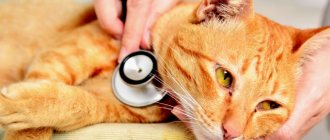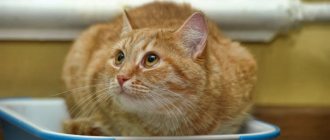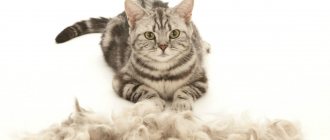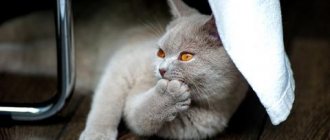5038Pavel
Disturbances in the gastrointestinal tract are very dangerous for cats. In particular, due to constipation, toxins can accumulate in the animal’s body, and feces can create pressure on internal organs and thereby disrupt their functioning. Is it possible to use Microlax for cats to give an enema and get rid of constipation? Isn't this dangerous for the animal, since the drug is intended for humans? What is the optimal dosage for an adult cat or kitten? You will get answers to all these questions in our article.
Indications for use
Microlax for cats is recommended for the following indications:
- constipation;
- examination of the stomach and intestines;
- carrying out a planned operation.
Microclysters are preferred by both veterinarians and cat owners. The drug is safe compared to oral laxatives, it is convenient to use, and the effect occurs faster than, for example, Vaseline oil.
Microclyster is a ready-made solution for one-time use. Unlike other enemas, the product does not require antiseptic treatment before use. The drug acts only in the rectum and does not affect other organs of the digestive system.
Composition and mechanism of action
Microlax contains peptizers - these are substances that break down feces into primary particles:
- sodium citrate displaces water;
- sodium lauryl sulfoacetate thins stool;
- sorbitol stimulates the flow of water into the intestines.
By thinning the stool, bowel movements are easier. Additionally, the product has an enveloping effect, which promotes the movement of feces through the intestines.
The incidence of side effects when using Microlax in cats is low. In rare cases, the following cases may occur:
- allergies with individual intolerance to the components of the drug;
- loose stools, less often diarrhea.
However, the use of Microlax in a cat should be regarded by the owner as a one-time emergency measure.
Dosage for cats
Microlax is available in the form of a solution for administration into the anus. The volume of one microenema is 5 ml. This dosage is for an adult. When a cat is constipated, use half the dose as for a child. There is a mark on the tube up to which you need to squeeze the product into the cat’s rectum.
The tip of the tube is too big for kittens. It is better to administer the product to a kitten through a small syringe without a needle. Dosage – 0.2-0.5 ml (depending on the size of the baby).
Rules for the procedure
Before learning how to give an enema to a cat with constipation, the owner must have an idea of what is needed for the manipulation and how to prepare the pet. For the procedure to be successful, you need to enlist the support of a reliable assistant. As a rule, cats do not perceive this kind of manipulation well and may resist. The assistant's task is to hold the pet while the enema is administered.
What to take
To carry out the procedure you will need the following supplies and materials:
- A special rubber bulb for douching. It is best to purchase a bulb with a rubber tip at a pharmacy kiosk. This modification does not injure the animal’s anus when the device is inserted. The volume of the pear depends on the age of the patient. For a small kitten, a 150-200 ml syringe is suitable. If the cat is an adult, the optimal volume of the pear is 300 ml.
- Container for diluted solution . Ordinary water can be used as the injected liquid. For effectiveness, it is advisable to add a little lemon juice, vinegar or half a teaspoon of petroleum jelly. Other types of oils are not recommended. Instead of oil, you can add a few drops of glycerin. On the recommendation of a veterinarian, you can use a salt solution (take 1 teaspoon of sea salt per 300 ml of water).
- water thermometer (the temperature of the injected liquid should be 25 - 30 degrees);
- Vaseline or baby cream for lubricating the tip of the syringe;
- gloves for hygiene;
- a wide basin instead of a regular tray for collecting stool.
In addition to devices and materials, the owner will also need calmness and clarity of action when performing the procedure.
We give an enema without a “scandal”
Before giving a cat an enema at home, the owner must understand that even a calm and phlegmatic animal in life is unlikely to easily accept such a procedure as bowel cleansing. Therefore, attention should be paid to securely restraining the pet. Experts recommend carrying out the procedure with an assistant. When acting alone, the cat is usually placed on the left hand, leaving the right hand for manipulation. Colon cleansing must be done on an empty stomach.
Fixing a cat in a pair
Having collected the required amount of liquid heated to the desired temperature into the syringe, you should squeeze the bulb so that a couple of drops of water come out. This is done to expel excess air. The tip of the syringe should be generously lubricated with Vaseline or baby cream.
Recommendations for use
The instructions for using Microlax for cats provide the same scheme as for people.
To give an enema you need:
- Break off the tip from the tube.
- Squeeze a drop of liquid to lubricate the tip for easy insertion.
- Gently insert the enema tip into the rectum about 1.5 cm.
- Squeeze out the contents of the tube and, without squeezing, remove the enema. You need to press quite hard, as the tube is hard.
After insertion, it is advisable to press the cat’s tail to the anus and hold it there for several minutes.
An enema is an unpleasant procedure for a cat and he will not sit quietly. It is important for the owner to behave calmly, talk to the pet, and pet it. Stress can make the problem worse. You may need an assistant to hold your pet and administer the enema.
Microlax begins to act in 5-15 minutes. However, this process occurs individually. The effect may occur within 40-60 minutes.
If there is no result, then after 3 hours the cat is injected with the second half of the tube.
After emptying, you need to look at the consistency and color of the feces. If the stool is black, this is a sign of bleeding in the intestines.
Constipation
Diseases of the gastrointestinal tract, liver, kidneys and neurological problems - each of the described disorders can result in regular constipation in a pet.
Constipation itself is not considered a disease, but one of the symptoms. It may indicate that the animal has problems with the body or some kind of pathology that is in the initial stages of development.
For constipation, it is very important to begin symptomatic treatment. In this state, the animal feels severe heaviness and other unpleasant sensations. It is important to remember that prolonged constipation in all cases leads to intoxication of the pet’s body.
According to statistics, it is mainly adults who suffer from long-term constipation, and cats are less susceptible to this effect than cats.
In most cases, cat owners complain of irregular constipation. The main reasons for the appearance of this symptom include:
- poorly composed diet;
- accidentally swallowed a small or large object;
- a large amount of hair that gets into the gastrointestinal tract when licked.
The main signs of constipation in a furry pet:
- regular lethargy, depressed state;
- the pet does not eat for a long time;
- bloating, possible unpleasant pain.
Experts note that in normal condition, cats should go to the toilet at least twice a day.
Contraindications
Microlax should not be used in cats if the following pathologies are present:
- Chronic gastrointestinal diseases. In this case, there may be wounds and ulcers on the mucous membrane.
- Volvulus or intestinal blockage. One of the reasons why a cat cannot pass a large bowel movement is a foreign body in the intestine. Most often these are bones or small objects. Feces physically cannot come out because of the obstruction. An enema in this situation will worsen the situation. The highest risk is intestinal rupture. Volvulus can only be treated surgically.
General information
Regardless of the etiology, almost all cases of fecal stagnation in animals are accompanied by drying out and significant compaction of feces in the lumen of the large intestine. If they are not softened first, any treatment will be either useless or deadly for the animal itself.
Thus, some breeders sincerely believe that human laxatives, like phenolphthalein (better known as Purgen), are excellent for constipation. phenolphthalein itself , keep in mind that a strong increase in intestinal peristaltic activity during constipation does not lead to anything good.
There are many cases where, as a result of such “treatment,” a cat suffered an intestinal rupture and died from painful shock. What is the reason for such a sad outcome? It's simple - when the intestines are clogged with dense and compacted feces, they gradually stretch. The smooth muscles responsible for intestinal motility also stretch and weaken. If you force it to contract sharply, the fabric may simply not withstand it and tear.
No constipation remedy taken orally is capable of rapid action. It will take (at least) several hours before the medicine, once injected into the animal's body, takes effect. And sometimes there is no time to wait, since the pet urgently needs relief. In such cases, it is unlikely that you can do without an enema. You can “bother” with syringes, oils and warm water, or you can use ready-made commercial formulations. These include Microlax.
Microclysters for intestinal cleansing
Cleansing procedures not only help fight constipation, but can also have a cleansing effect on the entire body.
To cleanse the intestines, you can use several recipes:
- Coffee solution . 3 tbsp. l. Ground coffee is brewed with a glass of boiling water and heated over low heat for 10–15 minutes. A solution at room temperature is filtered and injected into the intestines using a syringe. Such a microenema will help remove waste and toxins from the body, have a beneficial effect on the functioning of the biliary tract and liver, and eliminate colds at an early stage.
- Starch enema . It is used for inflammatory diseases of the colon, as it envelops and softens its walls. For cooking 5 gr. corn, potato, wheat, rice starch is diluted in 100 ml of cool water. Everything is mixed slowly and another 100 grams are added. boiling water The temperature of the injected solution should be 38–40C.
- Honey solution . In a glass of water at room temperature, dilute 1 tbsp. l. honey and lemon juice. The solution introduced into the colon must be kept for at least 10-15 minutes.
Folk remedies for microenemas
The use of folk remedies for microenemas for constipation can be a worthy alternative to medications. Such recipes are used at home; laxative solutions are prepared independently.
Medicinal plants and bee products are used to prepare laxatives, cleansers, and emollients. They not only help restore stool, but also relieve a person from bleeding, pain and inflammation from hemorrhoids. Home microenemas promote accelerated regeneration of the rectal mucosa.
Cleansing procedures
The action of a cleansing enema is aimed at removing hard, dense feces from the body. There are a huge number of recipes that can be used at home.
Coffee: 3 tablespoons of natural ground coffee should be poured into 250 ml of water, placed on low heat and simmered for 5 minutes. After this, you need to boil the liquid for another 10 minutes over high heat. Next, you need to strain the coffee, let it cool slightly and use it for the cleansing procedure.
Honey: in 1/3 of warm boiled water you need to dilute a spoonful of natural honey and the same amount of freshly squeezed lemon juice. When the honey is completely dissolved, the liquid is injected into the rectal cavity using a rubber syringe.
Potato starch: pour a spoonful of the product into a bowl with 100 ml of water, then place on low heat. The solution must be brought to a boil, stirring constantly and slowly adding another 100 ml of water. Microclysters with starch solution are carried out when the product has cooled to room temperature.
Means for laxative microenemas
To prepare homemade laxative solutions, various oils of plant origin are used that have pronounced laxative characteristics. It can be sunflower, olive, peach, castor, coconut or any other oil.
Method for preparing an oil solution - 50-90 ml of the plant product must be slightly heated in a water bath, and then used for microenemas. The laxative effect occurs 6-7 hours after the procedure, so it is best to perform it in the evening, before bedtime.
You can use another laxative recipe - dilute 3 tablespoons of vegetable oil in ½ glass of warm water and inject the prepared liquid into the rectal cavity.
An effective alternative to oil enemas is saline liquid, which you can easily prepare with your own hands. Magnesium sulfate in powder form is used for this purpose. You need to dilute a tablespoon of the drug in 250 ml of warm water, and then carry out a laxative procedure.
Milk for constipation
Whole milk, when introduced into the rectal cavity, has softening and thinning properties and promotes accelerated excretion of feces from the intestines. Heat 250 ml of milk over low heat, add 1-2 tablespoons of butter, stir thoroughly, cool and use for microenemas. To increase the effectiveness of treatment, you can add table salt to the liquid at the tip of a knife.
Medicinal herbs against constipation
Medicinal plants have anti-inflammatory, bactericidal, analgesic and wound-healing properties, due to which they are widely used to treat constipation and normalize stool.
The most commonly used medicinal herbs are:
To prepare a medicinal solution, pour a tablespoon of crushed raw material into 100-200 ml of hot water, then leave to infuse for half an hour, strain and use for enema.
What do the professionals advise?
The best time to perform a colon cleansing procedure is in the morning, when there is still a lot of time before breakfast.
The most convenient way to fix a cat is with a wide towel, when one end of it is wrapped around the animal’s body and tucked under the feet of the person administering the enema, the other end is wrapped in the same way. Thus, the fluffy begins to resemble a securely packaged package.
Cat in a towel ready for enema
This technique will not allow him to escape in the midst of the procedure and scratch the owner. To ensure the animal's calm before manipulation, you can give it a sedative medication.
Very good advice from experts is to use the help of an assistant, because it is not so convenient for one person to hold the animal and at the same time slowly administer the enema.
After completing the enema, you should thoroughly wash the animal, put its fur in order and provide complete rest so that it can quickly recover from stress.
Situations in which it is better to refuse the procedure
The question of whether it is possible to give a cat an enema yourself should be discussed with the attending veterinarian. Only a qualified specialist, based on a diagnostic study, can give an opinion on the advisability of the manipulation. The owner needs to know in what situations a cleansing enema can harm the pet:
- cat pregnancy at any stage;
- traumatic injuries to the anus and intestines, including foreign bodies;
- obstruction, intestinal volvulus;
- acute inflammatory processes in the large intestine;
- neoplasms of various etiologies;
- bleeding, including due to hemorrhoids;
How does the Microlax enema work?
Microlax is a popular and effective remedy for treating constipation in people. The drug is sold packaged in mini-enemas, which makes its use very convenient. Microlax is considered a safe product since the main active ingredients are of natural origin. When treating people, Microlax is prescribed to both adults and children, but the use of the drug is not recommended without prior consultation with a doctor.
Important! Drugs developed for humans are not always suitable for treating animals. Microlax mini-enema is no exception. Read the instructions carefully before starting self-treatment of your pet!
The active ingredients of the drug soften stool and bind air bubbles, which cause pain (colic). Mini-enemas contain a lot of water and have a viscous consistency, which leads to an enveloping effect. In addition, Microlax stimulates intestinal motility by contact.











